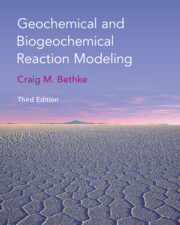Book contents
- Frontmatter
- Dedication
- Contents
- Preface
- Preface to Second Edition
- Preface to First Edition
- A Note About Software
- 1 Introduction
- 2 Modeling Overview
- PART I EQUILIBRIUM IN NATURAL WATERS
- PART II REACTION PROCESSES
- 14 Mass Transfer
- 15 Polythermal, Fixed, and Sliding Paths
- 16 Geochemical Buffers
- 17 Kinetics of Dissolution and Precipitation
- 18 Redox Kinetics
- 19 Microbial Kinetics
- 20 Association and Dissociation Kinetics
- 21 Kinetics of Gas Transfer
- 22 Stable Isotopes
- 23 Transport in Flowing Groundwater
- 24 Reactive Transport
- 25 Stagnant Zones
- PART III APPLIED REACTION MODELING
- Appendix A Sources of Modeling Software
- Appendix B Evaluating the HMW Activity Model
- Appendix C Minerals in the LLNL Database
- Appendix D Nonlinear Rate Laws
- References
- Index
20 - Association and Dissociation Kinetics
from PART II - REACTION PROCESSES
Published online by Cambridge University Press: 09 December 2021
- Frontmatter
- Dedication
- Contents
- Preface
- Preface to Second Edition
- Preface to First Edition
- A Note About Software
- 1 Introduction
- 2 Modeling Overview
- PART I EQUILIBRIUM IN NATURAL WATERS
- PART II REACTION PROCESSES
- 14 Mass Transfer
- 15 Polythermal, Fixed, and Sliding Paths
- 16 Geochemical Buffers
- 17 Kinetics of Dissolution and Precipitation
- 18 Redox Kinetics
- 19 Microbial Kinetics
- 20 Association and Dissociation Kinetics
- 21 Kinetics of Gas Transfer
- 22 Stable Isotopes
- 23 Transport in Flowing Groundwater
- 24 Reactive Transport
- 25 Stagnant Zones
- PART III APPLIED REACTION MODELING
- Appendix A Sources of Modeling Software
- Appendix B Evaluating the HMW Activity Model
- Appendix C Minerals in the LLNL Database
- Appendix D Nonlinear Rate Laws
- References
- Index
Summary
Chemists commonly find need to trace the rates at which aqueous species form complexes with other species in solution, or with reactive sites on mineral surfaces, and conversely how rapidly such complexes break apart. This chapter shows how kinetic rate laws applied to association and dissociation reactions can be incorporated into multicomponent chemical reaction models and provides a fully worked calculation, using aluminum fluoride complexing as an example.
Keywords
Information
- Type
- Chapter
- Information
- Geochemical and Biogeochemical Reaction Modeling , pp. 243 - 254Publisher: Cambridge University PressPrint publication year: 2022
